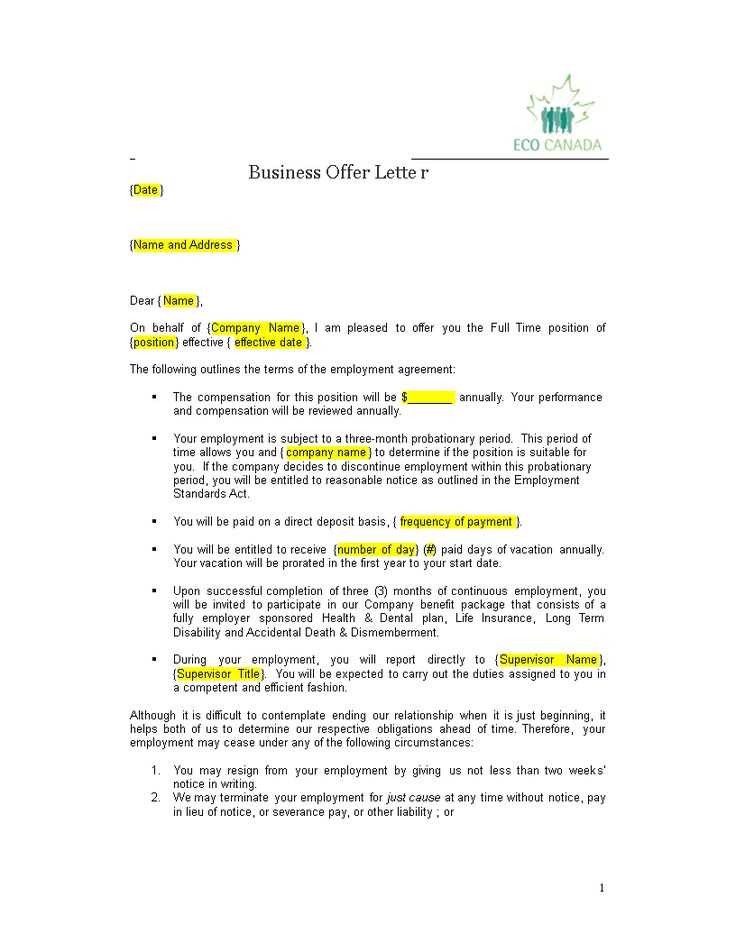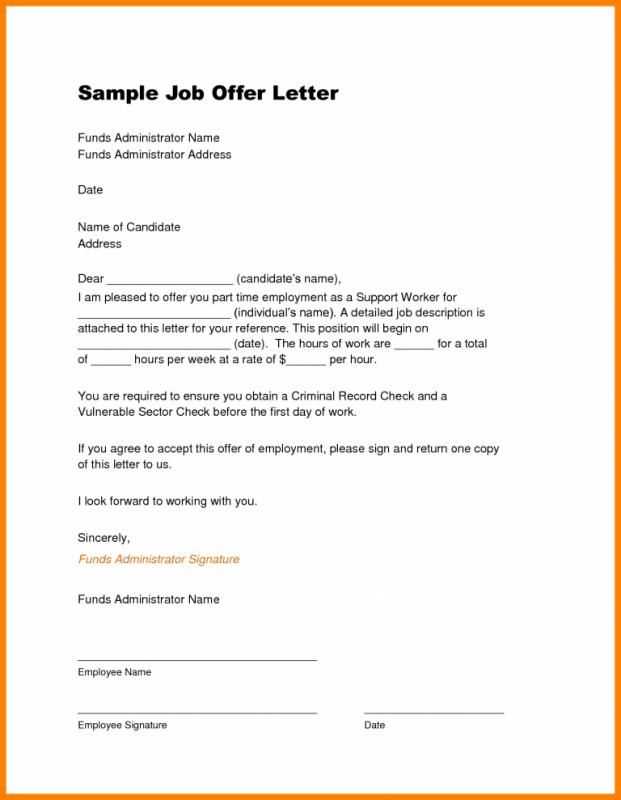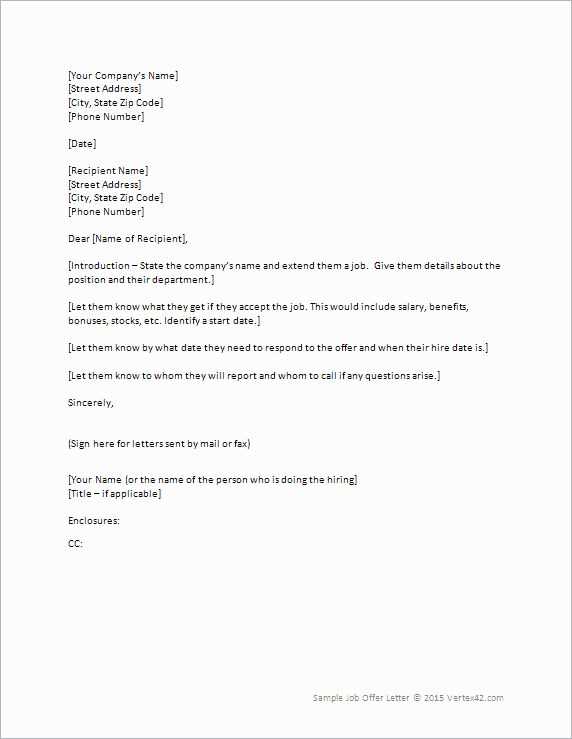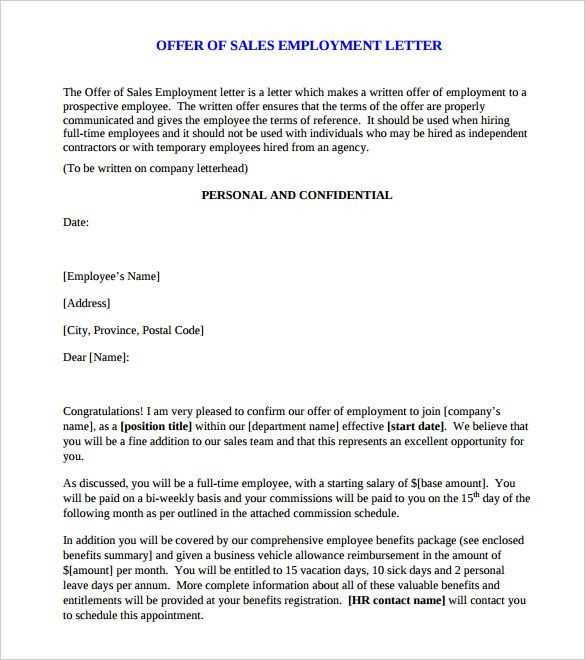Letter of employment offer template

Crafting a clear and well-structured employment offer letter is key to setting the right tone for a new hire’s journey with your company. A strong offer letter can help clarify expectations, solidify the candidate’s commitment, and prevent misunderstandings before they start. Here’s a template you can tailor to suit your specific needs.
1. Job Title and Reporting Line
Clearly outline the job title and the person to whom the new hire will report. This sets a clear foundation for their role within the organization and who they’ll interact with on a daily basis. Specify the department as well, if applicable.
2. Compensation and Benefits
State the salary and any additional compensation details, such as bonuses, commissions, or equity. Include the frequency of payment (weekly, bi-weekly, monthly) and highlight key benefits like health insurance, retirement plans, or vacation days.
3. Work Schedule and Location
Indicate the expected working hours, the location of the workplace, and any flexibility that might exist, such as remote working opportunities. Clarify whether the position is full-time or part-time and outline the workweek expectations.
4. Start Date and Terms of Employment
Specify the start date and any probationary period, if applicable. It’s important to state the terms clearly so that both parties are on the same page. Outline any conditions for employment, such as background checks or drug testing.
5. Acknowledgment and Acceptance
End the offer letter with a section asking the candidate to formally accept the offer by signing and returning the letter. This step formalizes the agreement and initiates the next phase of their employment process.
Here’s the revised version:
Begin with a clear and direct statement of the job offer. Specify the job title, start date, and primary responsibilities. Mention the agreed-upon salary or hourly rate and any bonuses or incentives. Outline benefits such as health insurance, paid time off, and retirement plans.
Be specific about work hours, including any flexibility, remote work options, and expectations for overtime. Clarify the reporting structure and who the employee will be working with directly.
Include any probationary periods or contract terms, if applicable. Ensure that the employee understands the expectations for performance and any consequences of failing to meet them.
End the offer with a call to action. Encourage the candidate to accept the offer by a specific date and provide instructions on how to formally accept the position.
- Letter of Employment Offer Template
Include a clear heading at the top of the letter. Use “Employment Offer” or “Offer of Employment” as the subject line to ensure clarity. Address the recipient by name, using a formal salutation like “Dear [Applicant’s Name].” State the position title explicitly, followed by the start date, ensuring there is no ambiguity.
Outline the basic terms of employment, such as compensation, benefits, and working hours. Be specific about the salary amount, frequency of payment, and any additional perks such as health insurance, bonuses, or stock options. Include details about probation periods, work schedule, and job location.
Clarify any contingencies or pre-employment requirements such as background checks or references. If applicable, provide the date by which the applicant must respond to the offer, and explain the next steps once the offer is accepted.
End the letter by expressing enthusiasm for the candidate joining the team. Use a polite closing such as “Sincerely” or “Best regards,” and provide contact details for further questions or clarification.
Begin with a clear and direct subject line that captures the purpose of the letter. For example: “Job Offer from [Company Name].” This immediately sets the tone and informs the candidate about the nature of the communication.
Opening Paragraph
Start the letter by addressing the candidate by name. Clearly state the position you are offering, the company, and the main terms of employment. Mention the start date, the job title, and any initial expectations. This section should communicate enthusiasm and clarity.
Job Details and Compensation

Provide specifics about the salary, benefits, and other compensation elements such as bonuses or stock options. Clarify the payment schedule–whether it’s weekly, bi-weekly, or monthly. Make sure the candidate knows what’s included in their total compensation package.
Outline working hours, reporting structure, and any conditions related to probation periods, if applicable. Ensure that both sides understand the job expectations and the candidate’s responsibilities.
Additional Terms and Conditions
Explain other important terms such as the duration of the contract, confidentiality agreements, non-compete clauses, or intellectual property rights if relevant. Be clear about the procedures for resignation, termination, or any other contractual obligations.
Finally, end with a call to action. Include a clear statement of how and when the candidate should respond to confirm their acceptance of the offer. Include a contact for any questions or clarifications.
Each employment offer must clearly outline key legal components to protect both the employer and the employee. Here are the main legal elements to include:
- Job Title and Description: Specify the position being offered and outline the primary duties expected of the employee. This helps set clear expectations.
- Compensation and Benefits: List the salary, hourly rate, or any bonuses, and detail other benefits such as health insurance, paid time off, and retirement contributions.
- Employment Status: Clearly state whether the position is full-time, part-time, temporary, or permanent, and include any probationary period if applicable.
- Work Schedule: Outline the regular working hours, including any flexibility, shift requirements, or on-call duties. Specify expectations for overtime, if any.
- Employment Start Date: Indicate the agreed-upon start date and any contingencies, such as background checks or drug testing that need to be completed before employment begins.
- Non-Compete and Non-Disclosure Clauses: If applicable, include clauses restricting the employee from engaging in activities that could conflict with the employer’s business or disclosing confidential information.
- Termination Conditions: Clarify the grounds under which either party can terminate the employment relationship, including notice periods, severance pay, and any conditions for immediate dismissal.
- At-Will Employment Statement: If applicable, include a statement that the employment is at-will, meaning either party can end the relationship at any time, with or without cause.
- Dispute Resolution: Include the method for resolving any legal disputes, such as arbitration or mediation, and whether the employee agrees to resolve conflicts outside of court.
These elements are necessary to create a legally binding and fair employment offer. Ensuring they are clearly defined minimizes risks and ensures that both parties are aligned on expectations and obligations.
Clearly state the official title of the position. Ensure it aligns with internal job structures and accurately reflects the role’s primary responsibilities. If the role is part of a larger department, specify its place within that hierarchy. This prevents any confusion and helps set expectations for the new hire.
Outline the main duties and tasks expected of the employee. Use concise language to avoid ambiguity. Break down the responsibilities into specific actions, such as managing projects, leading teams, or handling customer inquiries. This allows the candidate to fully understand their daily tasks and overall impact on the organization.
Consider including key performance indicators (KPIs) or measurable goals tied to the position. This helps both the employer and employee track performance and progress, ensuring both sides are aligned on expectations.
Be realistic and transparent about the scope of work. If the role requires flexibility, such as handling occasional overtime or dealing with a variety of tasks, mention it early on. A clear description of duties sets the stage for a smoother onboarding process and reduces the likelihood of misunderstandings later.
Clearly define the compensation and benefits structure to attract top candidates and ensure transparency. Establish a competitive base salary based on industry standards and the candidate’s experience level. Offer additional perks such as health insurance, retirement plans, and paid time off, which enhance the overall package. Tailor compensation elements to the role and the individual’s value to the organization.
Salary

- Research local market rates for similar positions to stay competitive.
- Consider performance-based bonuses or profit-sharing options.
- Factor in the cost of living adjustments, especially for remote or global roles.
Benefits
- Offer health, dental, and vision insurance options for employees and their families.
- Provide paid parental leave, vacation days, and sick leave to promote work-life balance.
- Consider additional benefits like gym memberships, mental health support, or transportation allowances.
Ensure benefits align with company culture and values while being flexible enough to meet employees’ diverse needs. Regularly assess the compensation package to maintain its attractiveness in a competitive job market.
Clearly state the start date in the offer letter. This provides the candidate with a firm timeline to plan for their new role. Ensure the start date is realistic, considering any necessary paperwork or arrangements the new employee might need to finalize.
Specify the key employment conditions, including work hours, location, compensation, benefits, and any probationary period. These details help both the employer and employee set clear expectations. For example, if there are any performance reviews or expected milestones within the first few months, outline them. Mention whether the role is full-time, part-time, or temporary and clarify whether any overtime will be required.
Be transparent about any policies or requirements, such as confidentiality agreements, non-compete clauses, or mandatory training. Clear and straightforward language regarding these aspects ensures there are no surprises for the employee after they accept the offer.
Focus on personalizing the offer by addressing the candidate by name. Include job-specific details such as position title, salary, and benefits to make it clear and transparent. For instance, specify the job location, work schedule, and reporting structure to avoid confusion. Customize the start date, making sure it aligns with the candidate’s availability and your business’s needs.
Ensure you clearly outline any performance expectations, milestones, or specific goals the candidate should achieve in the first few months. This gives both parties a shared understanding of success. For benefits, list specific offerings like health insurance, retirement plans, or bonuses that might differ for each employee.
To highlight the company’s values and culture, include a brief mention of what the organization stands for and how the new hire fits into that vision. Mention any unique perks or opportunities for growth that apply to the position. Providing clarity on these points helps set expectations and enhances engagement.
Always mention the contingencies, such as background checks, references, or any paperwork that must be completed before finalizing the employment. Specify the response deadline, so both parties are clear on timelines.
Here is a sample layout to follow:
| Component | Details |
|---|---|
| Job Title | Specific role (e.g., Marketing Manager) |
| Start Date | Exact date or flexible start period |
| Salary | Specific annual salary or hourly wage |
| Benefits | Health insurance, retirement plans, etc. |
| Work Schedule | Full-time, part-time, or flexible hours |
| Job Location | Office address or remote work options |
| Performance Expectations | Short-term goals or objectives |
| Response Deadline | Time frame for the candidate’s decision |
Specify the job title clearly. Make sure the position matches the expectations of the candidate and accurately represents the role they will be filling. This eliminates any potential confusion later on.
Include the Terms of Employment
Provide a detailed breakdown of the working hours, pay, and benefits package. Be transparent about any probation period and the conditions tied to the employment. Include the start date and any important deadlines.
Clarify Job Responsibilities

List the main responsibilities expected from the candidate in a straightforward manner. Avoid overly vague descriptions. Be concise, and focus on the tasks that are central to the role.
Provide details about the reporting structure and any necessary contact points for further questions. A clear line of communication will help both parties understand expectations from the outset.